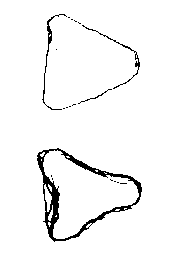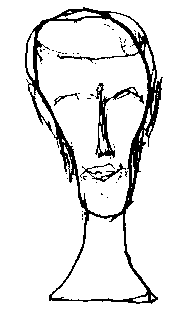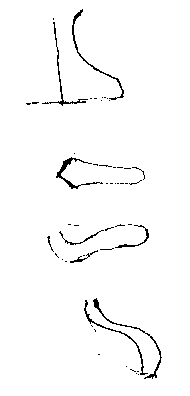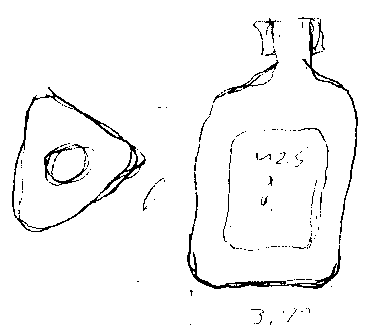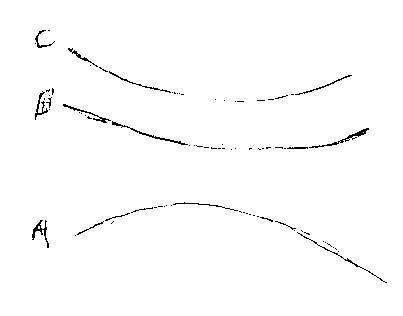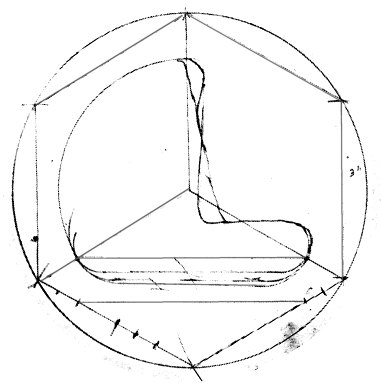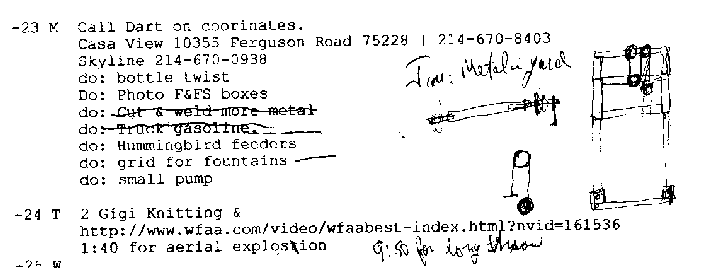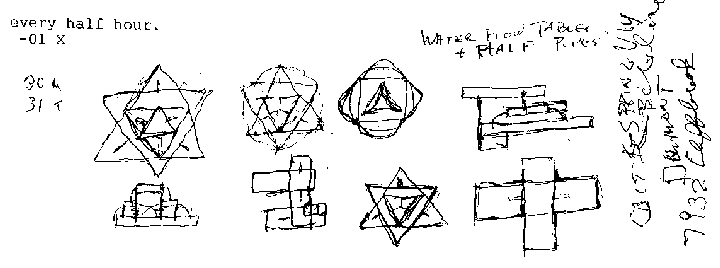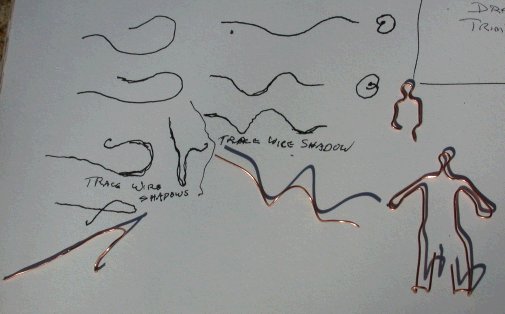|
DRAWING
TABLET PAD - Wacom dominates the market
in small digital tablets and I have one their smallest and cheapest:
Graphire. [http://global.wacom.com/graphire/features_benefits.cfm]. I find the
current version is bigger than the 3.6x5 active area one that I have and
now
has got Bluetooth as well as USB connection. Still comes with mouse
and pen. I love it and have enhanced it with springy little
accessory points that spread the pressure movement over greater distance
so it is more like a brush. Pressure can be used to change the
width, the opacity, or color of the drawn line. With tool options in
Paint Shop Pro I can make the brush build up as I go over an area.
Although my area is small, I find I can work as I wish, doing line drawing
and enlarging to do editing. I can see that someone used to arm
movements for drawing as opposed to my wrist and finger, would find my
size very limiting.
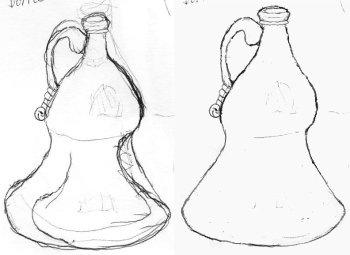 When I do drawing when traveling, I commonly
use a black ball point pen which does not erase, so I do over-drawing.
After scanning, I can edit, smooth, and modify to better represent the
object I am recording. The pen has a drawing point and an eraser end.
This is really handy when editing, because it means using it like a pencil
instead of selecting the erase tool with the pen end and then selecting
the draw tool to continue (which I can still do as the drawing tip has
more options than the eraser end.) Since I am often sketching in a hurry or
in an awkward location (and I am not wonderful as artist), I produce
drawings with multiple lines to get proportions more correct, etc. The
drawing shown is of a wide based brown bottle at the DMA. The first
sketching produced an image much more slender than the funky wideness of the
bottle so I redid the base and adjusted the left and lightly sketched in a
heavier mouth. On the computer after scanning, I erased unwanted and too
thick lines. By taking a selection of the original mouth and flipping
that, I was able to widen and raise the mouth to a more correct proportion
without trying to hand draw the symmetry again. I can see a few more
changes I might make for a more symmetric bottle, but this works.
2007-12-12 from Hot Glass Bits #49 2007-12-05 When I do drawing when traveling, I commonly
use a black ball point pen which does not erase, so I do over-drawing.
After scanning, I can edit, smooth, and modify to better represent the
object I am recording. The pen has a drawing point and an eraser end.
This is really handy when editing, because it means using it like a pencil
instead of selecting the erase tool with the pen end and then selecting
the draw tool to continue (which I can still do as the drawing tip has
more options than the eraser end.) Since I am often sketching in a hurry or
in an awkward location (and I am not wonderful as artist), I produce
drawings with multiple lines to get proportions more correct, etc. The
drawing shown is of a wide based brown bottle at the DMA. The first
sketching produced an image much more slender than the funky wideness of the
bottle so I redid the base and adjusted the left and lightly sketched in a
heavier mouth. On the computer after scanning, I erased unwanted and too
thick lines. By taking a selection of the original mouth and flipping
that, I was able to widen and raise the mouth to a more correct proportion
without trying to hand draw the symmetry again. I can see a few more
changes I might make for a more symmetric bottle, but this works.
2007-12-12 from Hot Glass Bits #49 2007-12-05
It is possible to draw in 3D with wire, which may make visualizing
something easy when the drawings just don't work, example
here. |
|
Clay
I have grown to like clay, especially Plasticine clay, for
working out ideas. Three modern forms of clay are available in small
quantities for easy use.
Sculpy is a modern plastic clay that comes in many colors and handles
reasonably well. It says soft at room temperature. It is widely used for
making jewelry and beads because when baked in an ordinary oven, it becomes hard
and glossy. It must not be overheated because the fumes are fairly
noxious.
Pottery clay is a natural product, dug from the ground, cleaned and packaged wet
or dry. Many, many versions are available. Small quantities of some types
may be had from craft stores with many other choices at ceramic and pottery
supply outlets. I use white potters clay, 25 pounds for about $10. All
potters clays are intended to be fired at a fairly high temperature and are weak
when air dried. They must be kept wet to be workable and if they dry out,
they can be rewetted if it is done slowly - quickly and the outer part becomes
sloppy while the inner is still rigid and fragile.
Plasticine clay is a mix of natural clay with oils that never hardens although
it is more or less stiff at various temperatures, softening when worked by hand,
hard to work at cool room temps. It is available in one pound bricks (and
bigger) in green from ceramic and sculptors supply sources and is the commonly
available multicolored sticks about the size of butter that are/were sold as
children's clay in grocery and toy stores.
Besides sketching in clay I have been
using it to make models for casting in brass and aluminum and though I
haven't used it this way, in glass powder (pate de verre).
|
|
Design
Any method that works can be used for design, but it really
helps to be able to modify the early versions. With drawing, this normally
means either drawing over the first lines, erasing part of the work, or
redrawing the essentials of the first lines and continuing. The latter, to
my mind, is the preferred method as it retains a record of what went before.
Also, by making several copies during the redrawing, one can go in several
directions. And, of course, if one is using pen, erasure is barely
possible (white out?) and overdrawing quickly becomes a mess. On a large
enough scale, it may be possible to use one or more colors of inks to impress a
couple of new ideas on the original and compare them by refocusing the eye and
mind.
|
